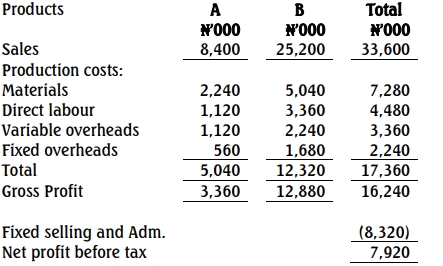- 20 Marks
MA – Mar 2025 – L2 – Q5 – Decision making techniques
Determine whether Moree Engineers LTD should make or buy extra seating assemblies for scooters, considering costs and opportunity costs.
Question
a) i)
Moree Engineers LTD (MEL) makes electrically-driven disability scooters aimed at elderly and/or disabled customers. At present, wheels and tyres are bought from external suppliers but all other parts are manufactured in-house. The scooters have a strong reputation due mainly to innovative designs, special power units that can be recharged at home and seats that enable easy access for a wide range of disabilities. MEL also sells power units to other firms.
Current monthly costs are as follows:
| Seating Department | Power Unit Department | |
|---|---|---|
| Costs | GH¢ | GH¢ |
| Direct Materials | 9,300 | 4,140 |
| Direct Labour | 12,600 | 9,450 |
| Apportioned overheads | 26,700 | 17,200 |
| 48,600 | 30,790 | |
| Production level | 60 units | 90 units |
The power unit department currently produces 90 units a month, 60 units are used in MEL’s own scooters while 30 units are sold externally at GH¢376 each.
A contract has been won to supply an additional 10 scooters per month. However, the directors are considering how best to meet the additional demand.
Sufficient capacity exists for the company to increase its monthly production to 70 scooters, except that making an extra 10 seating assemblies would require reallocation of labour and other resources from the power unit to the seating department. This would cut power unit output by 20 units per month.
The alternative course would be to buy 10 seating assemblies from an outside supplier and fit the 10 power units from the present production of 90 units. The cheapest quote for seating assemblies is GH¢610 per assembly.
Required:
Based on the figures given, show whether Moree Engineers LTD should make or buy the extra seats.
a) ii) Discuss FOUR other factors that should be considered before a final decision is taken to make or to buy the extra seats.
b) i). Bambo LTD produces three medical products namely, gloves, bandages and syringes. The budgeted sales in the coming year for the three products is GH¢4,530,000. The company accordingly projected GH¢750,000 post-tax profit on the three products for the period.
Detailed budgeted Cost and sales data for the coming year are as follows:
| Gloves | Bandages | Syringes | |
|---|---|---|---|
| Sales Volume (%) | 40% | 25% | 35% |
| Variable cost to Sales ratio | 60% | 67.5% | 54.5% |
The fixed cost for Bambo LTD amounted to GH¢1,330,000.
Other information:
Corporate tax rate is 25%
Required:
Calculate margin of safety in percentage (%) terms.
b) ii) Calculate post-tax revenue to achieve the projected profit.
Find Related Questions by Tags, levels, etc.
- Tags: CVP Analysis, Multi-product, Post-tax revenue, Profit Calculation, Tax adjustment
- Level: Level 2
- Topic: Cost-Volume-Profit (CVP) Analysis
- Series: MAR 2025







